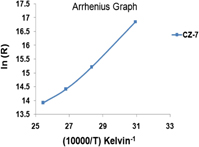Crossref Citations
This article has been cited by the following publications. This list is generated based on data provided by
Crossref.
Cao, B.S.
Rino, L.
Wu, J.L.
He, Y.Y.
Zhang, Z.Y.
Feng, Z.Q.
and
Dong, B.
2017.
Temperature- and humidity-sensing properties of ZnO:Yb/Er nanocrystal clusters synthesized by a facile microwave-assisted approach.
Sensors and Actuators A: Physical,
Vol. 268,
Issue. ,
p.
110.
Srivastava, Tulika
Sadanandan, Aswin
Bajpai, Gaurav
Tiwari, Saurabh
Amin, Ruhul
Nasir, Mohd.
Kumar, Sunil
Shirage, Parasharam M.
Biring, Sajal
and
Sen, Somaditya
2017.
Zn 1−x Si x O: Improved optical transmission and electrical conductivity.
Ceramics International,
Vol. 43,
Issue. 7,
p.
5668.
Abdul, Shaban
Judit, Telegdi
Ilona, Felhősi
and
Nikoletta, Molnár
2018.
Fundamentals of Nanoparticles.
p.
485.
Zhang, Dongzhi
Zong, Xiaoqi
Wu, Zhenling
and
Zhang, Yong
2018.
Ultrahigh-performance impedance humidity sensor based on layer-by-layer self-assembled tin disulfide/titanium dioxide nanohybrid film.
Sensors and Actuators B: Chemical,
Vol. 266,
Issue. ,
p.
52.
Papamatthaiou, Sotirios
Argyropoulos, Dimitrios-P.
Farmakis, Filippos
and
Georgoulas, Nikolaos
2019.
Investigation of the H2O Sensing Mechanism of DC-Operated Chemiresistors Based on Graphene Oxide and Thermally Reduced Graphene Oxide.
IEEE Sensors Journal,
Vol. 19,
Issue. 18,
p.
7841.
Din, Alaud
Karimov, Kh.S.
Akhtar, Kalsoom
Asiri, Abdullah M.
Gul, Saima
Khan, M.I.
Ali Khan, Murad
Bakhsh, Esraa M.
and
Bahadar Khan, Sher
2022.
ZnO-CuO nanomaterial based efficient multi-functional sensor for simultaneous detection of humidity and mechanical pressure.
Inorganic Chemistry Communications,
Vol. 145,
Issue. ,
p.
109897.
Sarangi, S.N.
Acharya, S.
Biswal, S.K.
and
Nanda, K.K.
2022.
Dependence of Cu doping on structure, morphology, magnetic and biomedical properties of ZnO nanostructures.
Materials Today Communications,
Vol. 31,
Issue. ,
p.
103803.
Kalangestani, F. Chharganeh
Simiari, M.
and
Ghodsi, F. E.
2022.
Fabrication of V2O5/NiO double-layer film with hydrophilic property and evaluation of the effects of V2O5 coating on electro-optical parameters of NiO film.
Applied Physics A,
Vol. 128,
Issue. 5,
Gupta, Priya
Kumar, Kuldeep
Saeed, Syed Hasan
Pandey, Narendra Kumar
Verma, Vernica
Singh, Peramjeet
and
Yadav, Bal Chandra
2022.
Influence of tin doping on the liquefied petroleum gas and humidity sensing properties of NiO nanoparticles.
Journal of Materials Research,
Vol. 37,
Issue. 1,
p.
369.
Subki, A. S. R. A.
Mamat, M. H.
Manut, A.
Birowosuto, M. D.
Musa, M. Z.
Ahmad, M. Y.
and
Rusop, M.
2022.
Enabling Industry 4.0 through Advances in Manufacturing and Materials.
p.
395.
Kumar, Ankit
Gupta, Gaurav
Bapna, Komal
and
Shivagan, D.D.
2023.
Semiconductor-metal-oxide-based nano-composites for humidity sensing applications.
Materials Research Bulletin,
Vol. 158,
Issue. ,
p.
112053.
Abdulsattar, Mudar Ahmed
Abduljalil, Hayder M
and
Abed, Hussein Hakim
2023.
Reaction mechanisms of pristine and Cu-doped ZnO clusters with ethanol using Evans–Polanyi principle.
Emerging Materials Research,
Vol. 12,
Issue. 1,
p.
60.
Rehman, Muhammad Muqeet
Khan, Maryam
Rehman, Hafiz Mohammad Mutee ur
Siddiqui, Ghayas Uddin
Ahmad, Zubair
Ali, Kamran
Khan, Shenawar Ali
Saqib, Muhammad
Gul, Jahanzeb
and
Kim, Woo Young
2024.
Handbook of Nanomaterials, Volume 1.
p.
513.
Manjunatha, K.
Chethan, B.
Yun Wu, Sheng
Ubaidullah, Mohd
Al-Kahtani, Abdullah A.
Dhakal, Thakur
and
Jagadeesha, Angadi V.
2024.
Synthesis of Li doped MgFe2O4 nanoparticles for humidity sensor applications.
Ceramics International,
Vol. 50,
Issue. 15,
p.
27287.
Yanto, Wahyu Fitri
Salim, Abdan Qolbun
Lathifah, Khansa
Rohman, Arief Dwi
Suryadi
Azzahiidah, Rifda
Ansari, Abu Saad
and
Rochman, Nurul Taufiqu
2024.
Humidity sensors based on doped ZnO: An overview.
Materials Today: Proceedings,
Pascariu, Petronela
Tudorache, Florin
Romanitan, Cosmin
Serban, Andreea Bianca
and
Koudoumas, Emmanouel
2025.
1 % lanthanide-doped ZnO nanostructures as a versatile approach for state-of-the-art capacitive and resistive humidity sensors.
Ceramics International,
Vol. 51,
Issue. 13,
p.
17090.
Tseng, Shih-Feng
Cheng, Yu-Feng
Jong, Chao-An
and
Hsu, Shu-Han
2025.
Highly sensitive humidity sensors based on Ag-BVO composites.
Journal of Alloys and Compounds,
Vol. 1014,
Issue. ,
p.
178802.



